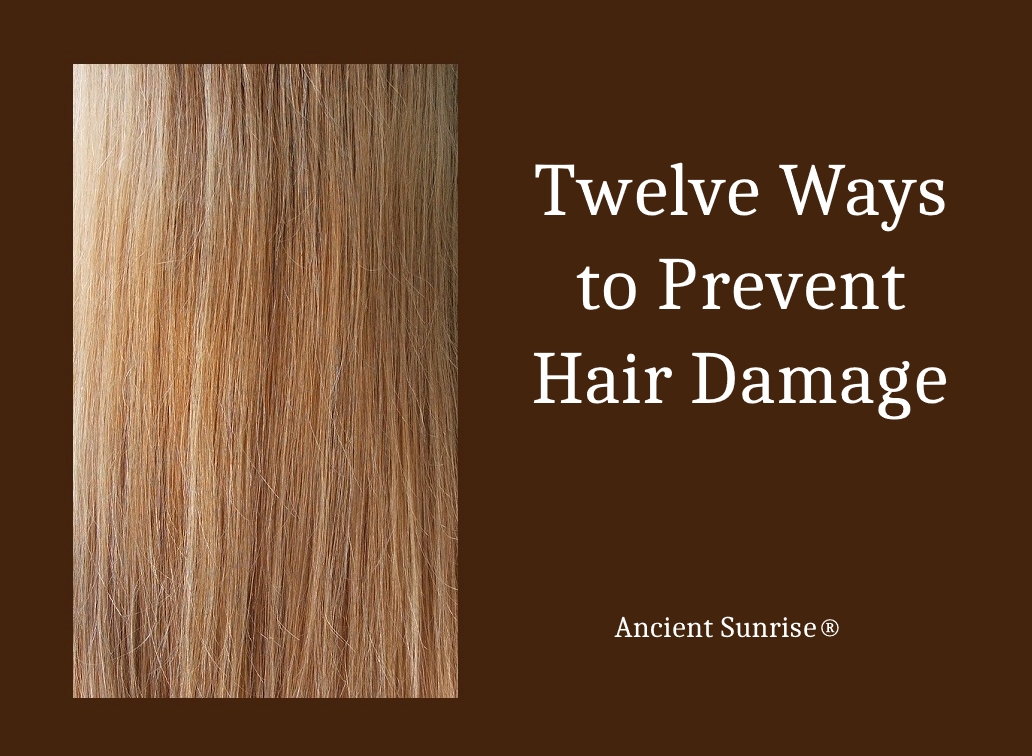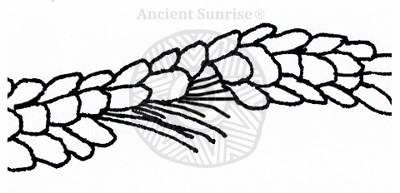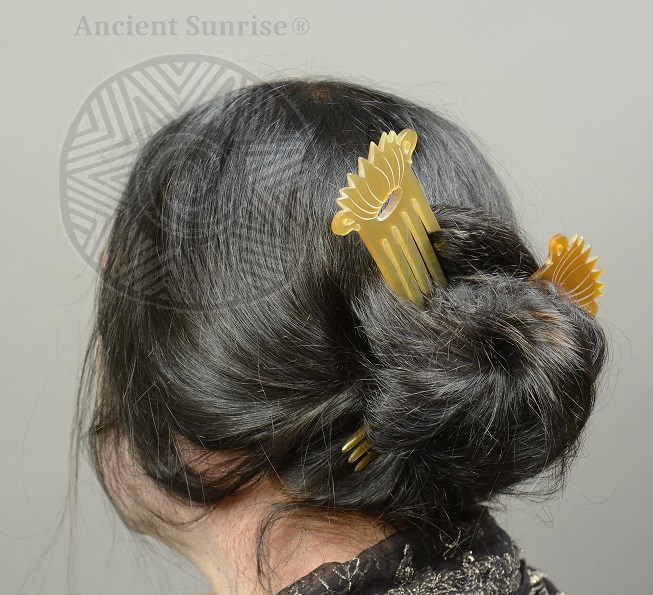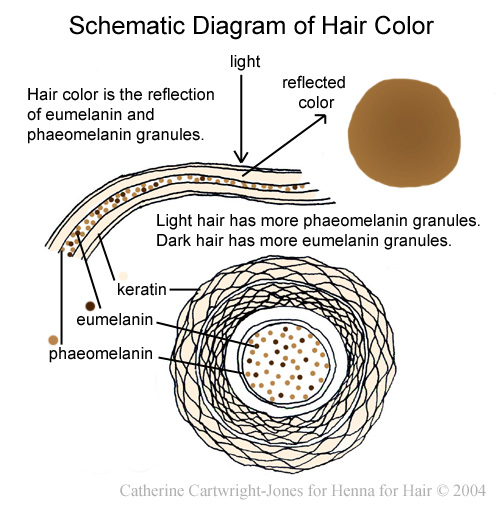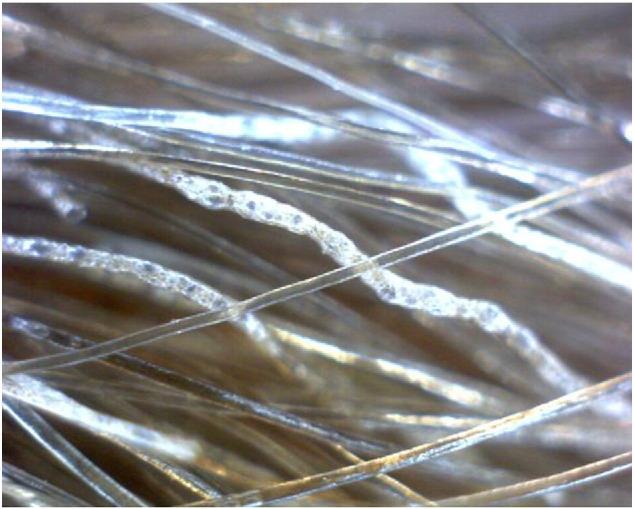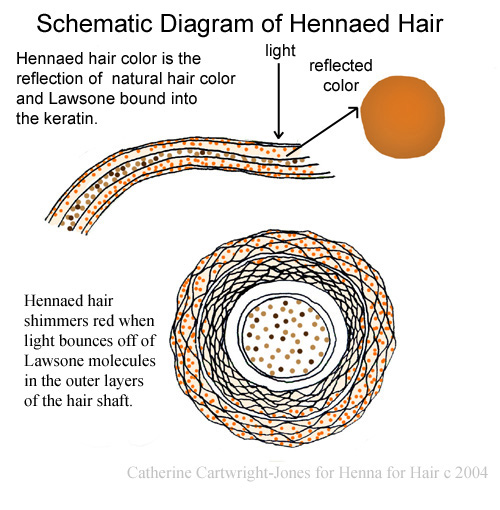
The dye from the henna (lawsonia inermis) plant is called lawsone. If extracted and isolated from the plant, lawsone is a bright orange color. When henna leaves are harvested, dried, and made into powder, and that powder is subsquently mixed with an acidic liquid to form a paste, the lawsone precursor molecules which exist in the henna is released as an intermediate molecule called an aglycone. This aglycone molecule can attach to keratin—such as that which forms the outer layers of hair stands and skin– and then oxidize to its final, stable form. The result on light hair is anywhere between a bright, fiery copper to a deep auburn.
There is no such thing as “brown henna,” or “black henna.” Products with such labels most likely contain some henna along with additional plant dye powders, or even synthetic dyes such as para-phenylenediamine (PPD). This goes for both products marketed for hair use as well as for use on the skin. The truth is, pure henna will only color keratin a variation of orange to red-orange.
In order to achieve a darker result when using henna, something must be added to the henna mix, or the hair/skin must be exposed to heat during or after processing.
This article will explain what can be done to safely and effectively deepen henna results on hair*, as well as what should not be done.
*Note: The same kinds of rules do not always apply in the same way to henna used on the skin. For more information on henna as body art, read “Henna for Body Art 101: How to Achieve a Dark, Long-Lasting Stain” in BecomingMoonlight.Blog. Please also note that if you live in the United States, the FDA does not allow the use of henna for body art purposes (i.e., coloring the skin). Here are the US FDA regulations for the use of henna for the purpose of body art. These regulations have the force of law: https://www.fda.gov/cosmetics/productsingredients/products/ucm108569.htm
Do: Mix your henna powder with an acidic fruit juice
For a rich, vibrant result, it is important that the henna paste properly dye-releases. Water alone is not enough and will cause light, brassy results. A mildly acidic liquid allows the maximum release of aglycone molecules by keeping them in a hydrogen-rich environment. Water releases some dye molecules, but cannot keep them in their intermediate state as well. The result from a water-only mix is lighter and often less permanent because dye molecules either have not released from the plant material or have released and oxidized to a final state which cannot bond to keratin; therefore, fewer aglycones are available to color the hair. The dye molecules bond to keratin by way of a Michael Addition, which requires the extra hydrogen ions that exist in an acidic solution.
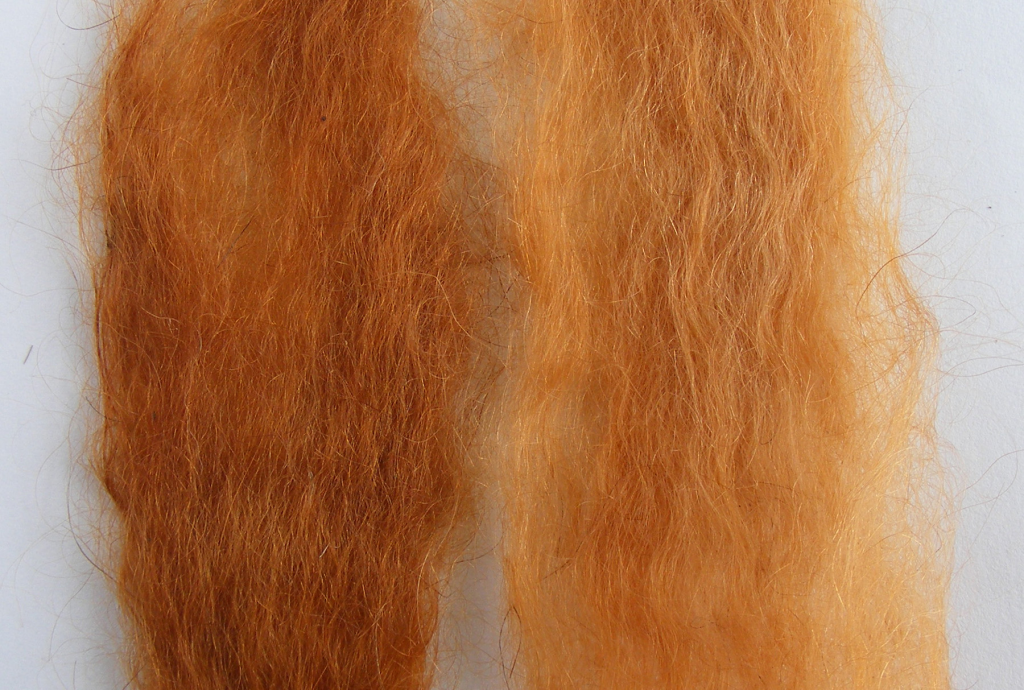
The sample on the left was dyed with henna mixed with an acidic liquid. The sample on the right was dyed with henna mixed with water.
Leaving an acidic paste at room temperature allows for a slower, and better-controlled release of the maximum amount of aglycones. More dye molecules become available in the paste over time, while the acidity prevents rapid oxidation of those molecules (demise). At room temperature, an acidic henna mix is ready after eight to twelve hours. To learn more about proper dye release, read Chapter Six of the Ancient Sunrise Henna for Hair E-Book and “Henna 101: How to Dye-Release Henna” in this blog.
The liquid does not have to be overly acidic. A pH of 5.5 is sufficient. Lemon juice, with a pH of 2-3, is very acidic. Lemon juice can be diluted with 1-3 parts water for an effective mixing liquid. Undiluted lemon juice should be used with care and avoided by those with sensitive skin. To read more about using lemon juice in henna mixes, read The article titled “Should You Be Using Lemon Juice In Your Henna Mix?”
Other fruit juices such as orange, apple, and cranberry are effective for mixing with henna. However, cranberry is often recommended for keeping results lighter and brighter, as the antioxidant content in cranberry juice may prevent darkening.
Ancient Sunrise® also offers fruit acid powders which can be used with distilled water to create a mildly acidic solution. The fruit acid powder called Malluma Kristalovino is gentle on sensitive skin and can help make results deeper. Nightfall Rose fruit acid powder adds subtle ash tones to henna. Amla fruit acid powder can help a henna/indigo mix bind more effectively to hair for deeper, cooler brunette shades.
Don’t: Mix your henna with coffee
Mixing coffee with henna has been recommended by other sources as a way to deepen resulting colors. This has been proven to be ineffective. Not only will adding coffee do very little to the color, but the trans-dermal nature of caffeine will leave a person with jitters or a bad headache. Henna paste needs to be left on for at least three hours. During that time, caffeine would be entering the bloodstream through the skin at a rather rapid rate. Additionally, the paste would smell quite unpleasant.
Do: Apply heat during processing and/or after rinsing
Heat causes the outer cuticle layers of hair strands to open up, thus allowing better dye penetration. Once you have applied the henna paste to your hair and have wrapped it up, keep your head warm by covering it with a thick, knitted cap or a towel. You may also choose to aim a hairdryer at your head for intervals of a few minutes at a time, or sit somewhere warm and sunny. Heat can both speed up processing time and ensure a more saturated result.
After the henna paste has been rinsed out, you may choose to use heat again to speed up the oxidation process. Hennaed hair is naturally lighter and brighter first upon rinsing, and will take several days to a week to settle into its final color. Using a hair dryer or heat styling tools can cause oxidation to occur more quickly. Continual use will darken hennaed hair more and more over time. This darkening is permanent, and can only be reversed with the use of lightening products. Those who wish to avoid causing their hennaed hair to darken should avoid excessive use of heat styling.

Don’t: Mix henna paste with hot or boiling liquid
Many henna for hair products instruct users to mix the powder with hot or boiling water. This technique leads to a rapid release, and subsequent demise, of the dye molecule. As stated above, an acidic liquid allows for more aglycones to be available in the paste at the time of application. The boiling-water method of mixing henna causes lighter, brassier results. With henna, as many other good things in life, patience is key.
Do: Apply henna to clean hair
The sebum, dirt, minerals, and product buildup in unwashed hair prevent dye uptake. For the best results, apply henna to hair that has been treated with Ancient Sunrise Rainwash mineral treatment followed by a clarifying shampoo. At the very least, shampoo your hair very well. Skip the conditioner. Particularly oily or resistant hair can be washed with a few drops of dish-washing detergent to ensure it is ready for dyeing.
If you are a no-poo or low-poo person, this does mean you will have to break your regimen just once if you want the best results. There is just no way around it. Baking soda and vinegar, clay, natural herbs, or any other washing methods will not remove sebum, dirt, and mineral buildup effectively enough for the purposes of coloring hair with henna.
Don’t: Add oils to a henna for hair mix
Just as oils on the hair will prevent effective dye uptake, so will oils added to a henna mix. While some might believe that adding oils or even other ingredients such as milk or yogurt to a henna mix may help, they do not. To read more about what not to add to a henna mix, read Don’t Put Food On Your Head.
Certain types of essential oils, called “terps” (short for monoterpene alcohols) are added to henna pastes made for body art. When used on skin, “terped” henna results in deep burgundy to near-black stains. However, essential oils should not be used in henna for hair. They can cause the resulting color to be muddy (not darker in a desirable way). In addition, leaving a paste containing essential oils on the head for an extended period of time will lead to headaches and scalp irritation.
Do: Add indigo for brunette results
As discussed earlier, the lawsone molecule from henna can provide orange to auburn results when henna plant powder is used alone. In order to achieve brunette tones, another plant dye powder must be added. Indigo plant dye powder contains dye of the same name. This is the dye that was originally used to color denim, and is still used today in many textile traditions. The type of indigo powder used in henna mixes is called vashma indigo. This is made from indigo leaves that have been partially fermented before being dried and powdered. If used on its own on light hair, indigo may color hair grey-blue, sometimes violet, and sometimes a blueish green. The effect is difficult to control and not as permanent as henna.
When used in the right ratios, henna and indigo together will color light hair virtually any natural brunette shade from medium brown to warm black. Unlike henna, indigo does not need acid and time for dye release. It must be mixed with only water just prior to application. To add indigo to henna, mix the powder with distilled water until it is a similar consistency as the henna paste, then combine it thoroughly with dye-released henna paste and apply immediately.
To learn more about indigo, read Chapter Five of the Ancient Sunrise Henna for Hair E-book. To learn what henna/indigo ratio is best for your desired outcome, see “Henna for Hair 101: Choosing Your Mix.”
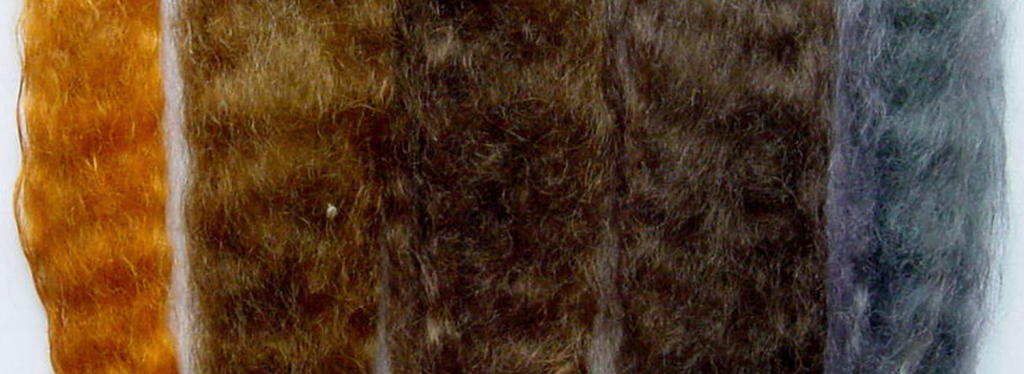
Don’t: Add black walnut powder, anything claiming to be “Buxus” or “Katam,” or synthetic dyes
Black walnut powder is sometimes mentioned in natural hair care communities for the use of dyeing hair brown. The effect is not as permanent as henna. Additionally, black walnut is known to cause allergic reaction for many people. It is therefore best avoided.
Buxus dioica, also called katam, is a plant that works similarly to indigo when used with henna. The result is shades of brunette. However, buxus was only grown in and exported from Yemen. The conflict occurring within the country has ceased exports and production of buxus and other goods. There are a few vendors which claim to carry buxus. At best, those products are in all actuality indigo powder labeled as buxus. At worst, they contain dangerous or ineffective ingredients.
Do not add synthetic (store-bought or salon) hair dyes to your henna mix. They are not compatible and are not meant to be used in the same mixture. Oxidative dyes color the hair through a very different chemical process than henna. Do not try to add other types of dyes, such as fabric dye or food coloring.
You can, however, safely use semi/demi-permanent or oxidative dyes over hair that has been colored with Ancient Sunrise® henna for hair products (and no other henna product), as the plant powders sold by Ancient Sunrise® have been tested in an independent lab to ensure they do not contain mineral salts or other adulterants which may react with synthetic hair products.
Also Don’t: Use premixed “henna for hair” products
Some “natural” hair coloring products which promise a brunette or black result declare a combination of henna, indigo, and/or other plant ingredients. Because henna and indigo must be prepared separately, any product which blends the plant dye powders together is likely to produce inferior results.
Some products labeled as henna for hair may also contain azo dyes (such as Red 33) or oxidative dyes (such as PPD). The requirement for ingredients declarations varies from country to country so that some products manufactured outside of the US do not report all of the ingredients which they contain. While such products are not allowed to enter the United States, all too often they slip by. It is best to stick with purchasing pure plant dye powders in separate packages and mixing them yourself. While a pre-mixed product may seem tempting, opting for Ancient Sunrise® products and methods allows you to keep your peace of mind.
Do: Repeated applications of henna
While henna does not “coat” the hair, repeated applications will cause your hair to be more saturated with dye each time. We often recommend to only color new hair growth after a person has achieved their desired color. This is because repeated applications will cause darkening over time. However, if you are looking for a deeper, richer color, feel free to reapply henna to the entire length of your hair until you get it to where you like. Unlike with conventional dyes, repeated applications will not damage the hair; in fact, continuing to use henna will condition and strengthen the hair.
Leaving the paste in your hair longer can also contribute to a deeper result. However, only do this if you are not using indigo. Indigo’s dyeing power begins to slow after about three hours, after which the henna part of a henna/indigo mix will continue to color the hair. The result of leaving a henna/indigo mix on the hair longer than three hours may be redder than desired.
Don’t: Re-henna too hastily
Keep in mind that henna’s color naturally deepens over the course of the week following application. If you rinse your henna out and immediately feel that it is just a couple of shades too bright, wait at least a few days before reassessing. You may find that a little bit of time is all you needed to reach your desired shade. Reapplying too quickly may cause you to overshoot, and end up with a final color that is much darker than intended.

